1110 Search Results for Core
February 13, 2013
by Carole Zangari -
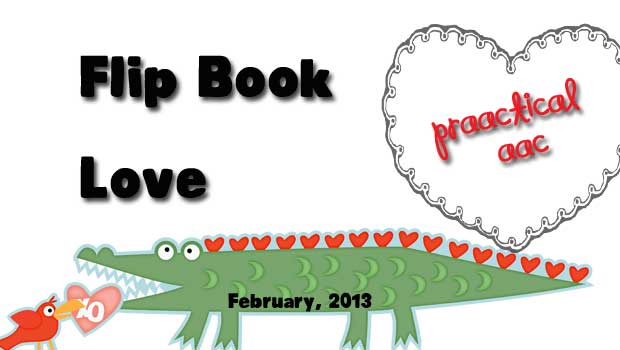
We love the versatility of flip books and charts. They are a great format option for communication books, particularly the flip books that have a static ‘base’ and a set of strips/mini pages that you can flip through for additional vocabulary. Once you have a template, it’s not too difficult to make a number of them that fit different purposes. Here are some resources to explore. SET-BC has wonderful material on communication supports including a brief video about flip books here. They also have some terrific downloads, including this one by Kathy Ryan. Flip ‘n Talk has been around for a long time, but it continues to be a really useful tool. We typically have the core language as the static portion, but here’s an example of doing it the other way around. There are so many ways to use flip books for language learning. We love this one for... [Read More...]
February 12, 2013
by Robin Parker -
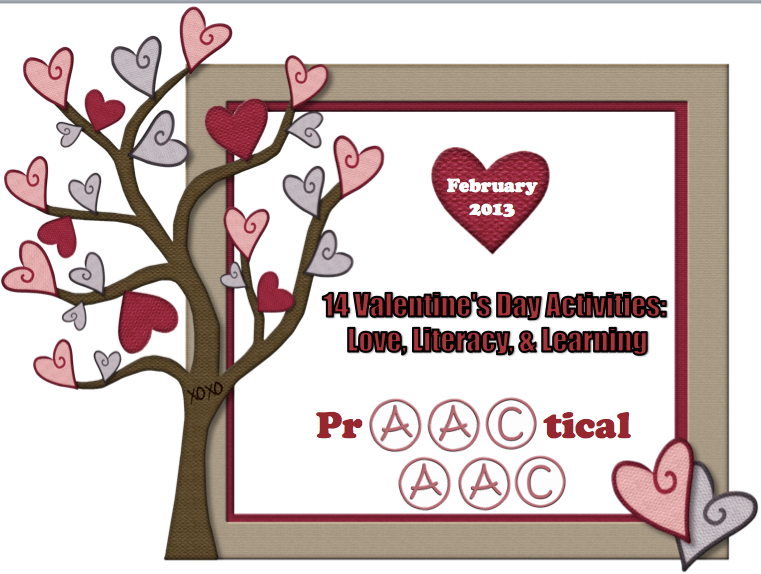
14 Valentine’s Day Activities for Love, Literacy, & Learning Valentine’s Day is a theme that seems to take precedent in February. When we use this theme, we like to focus on it before, during, and after February 14th because then there is a lot of opportunity to talk about it before, during, & after the holiday. This is like conversation which involves so much more than talking about the ‘here & now’. For the Computer: Use Heart Generators http://www.cryptogram.com/hearts/ http://acme.com/heartmaker/ http://www.bobarmadillo.com/sluggyv-day/ Use Word Clouds Taxedo Wordle Image Chef Practice Valentine’s Day Spelling Words Research Valentine’s Day & Write Key Fringe Vocabulary Create sentences with core words using multiple hearts Write word poems using heart generators Have students take turns telling you or another student what to write on the hearts Apps Special Valentine Day Apps First Words Valentines– Free- learn and spell key Valentine’s Day vocabulary. Nice errorless learning... [Read More...]
February 6, 2013
by Carole Zangari -
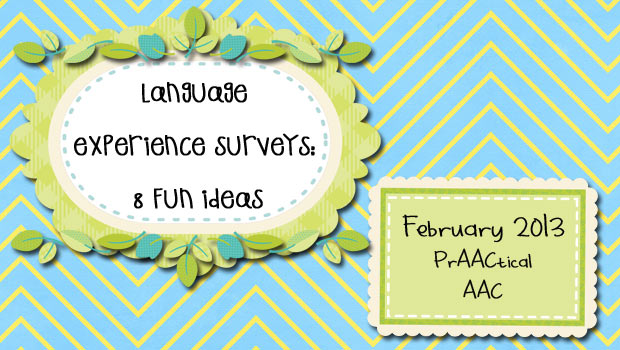
In a previous post, we talked about the fun ways to get in some good AAC practice with language experience surveys. Here are some great examples of survey-related materials that we found on one of our favorite communities, Boardmaker Share. Hot Chocolate Survey by Sharon Maack-Connolly What I Did Over the Holidays by Becki Ratcliffe I Can (corresponds with MeVille to Weville but also good for any core language practice) by Alison R Songs About America by Kate Ahern How Do You Like to Travel by Vicki Clarke My Opinion: Pets by Vicki Clarke How Do You Get to School by Tiffany Paul What is Your Favorite Fast Food Restaurant by Tiffany Paul We’d love to hear more prAACtical ideas for using language experience surveys.
February 4, 2013
by Carole Zangari -

We are still looking over content and finding more goodies from AAC presentations at the Atlanta ASHA Convention. Meet Core Content & State Standards for Students Using AAC by Deborah Witkowski and Bruce Baker Effective Parent Training Strategies for Teaching Communication Across Various Modes by Courtney Wright and Megan Roberts Semantic-Syntactic Coding & Analysis for a Child Using Aided AAC by Cathy Binger, Eliza Webb, Marika King, and Marysa DeBlassie Evidence-Based Practices for Use of Visual Scene Displays (VSDs) by Libby Rush and Celeste Helling Community-Based AAC iPad Lending Library: Getting It Up & Running by Ellen Holloway and Kelly Crouch
February 2, 2013
by Carole Zangari -
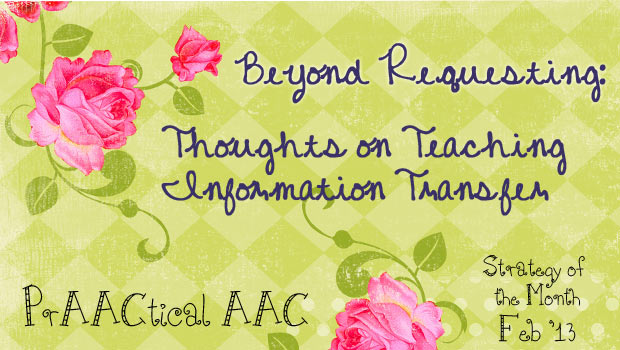
Although it has been close to 25 years since Dr. Janice Light’s hallmark paper on communicative competence in AAC discussed four main purposes of communication, many AAC systems are still heavily populated with messages for basic wants and needs. The other areas – information transfer, social closeness, social etiquette – are often underrepresented in AAC systems. We scratched the surface of how to teach basic requesting last month, and now we’re ready to talk about communicating for other reasons. In this post, we’ll talk about some of the clinical issues in teaching communication for the purpose of information transfer. A big reason that we express ourselves is to share information that others want or need. It may not seem like a high priority until we realize how often we need to do this to function in our daily lives. Here are some examples, both positive and negative, from our work... [Read More...]
January 31, 2013
by Carole Zangari -
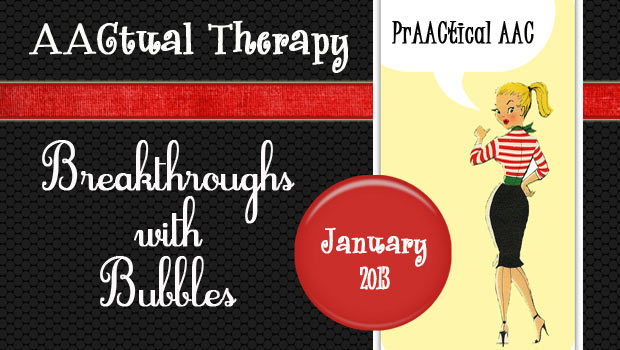
We couldn’t be happier that one of our first AACtual Therapists is Tanna Neufeld, a south Floridian on loan to the Pacific Northwest. Tanna was with us as a graduate student many years ago, and went on to build a fantastic reputation in our community for her excellent clinical skills. It was South Florida’s loss when she left last year and moved across the continent. (I know at least a few people scheming of ways to get her back.) Tanna is now working at the Children’s Therapy Center in Seattle. Tanna blogs at SNEAK Outside the Box and My Blind Side. You can read more about her at the end of this post, in which Tanna talks about using bubbles in her AAC therapy sessions. AAC Breakthroughs with Bubbles! When I first started using core vocabulary boards with my kids, I didn’t really know where to start. It was really... [Read More...]
January 26, 2013
by Carole Zangari -
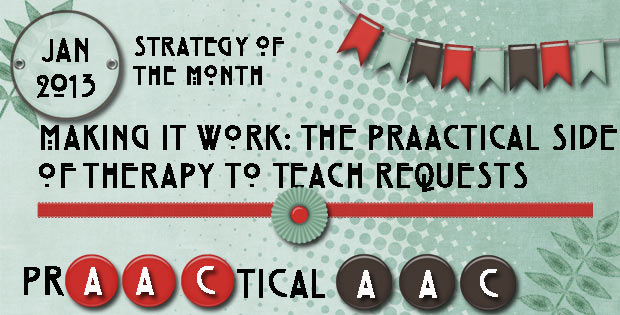
This month we’ve been talking about requesting and choicemaking, specifically how to teach it. Today, we’ll put it into a clinical context by talking about a hypothetical session that targets this skill, but also highlights other strategies. As you read about the materials, preparation, and script, look for how they incorporate strategies such as building specific communication opportunities {CO}, aided language input {ALI}, and expansions {EX}. The clinician also builds in repetition with variety so that there is sufficient opportunities for teaching and practice using multiple modes of communication. In this scenario, you’ll meet Jenna, a 5 year old with significant language difficulties secondary to Cri du Chat syndrome. Jenna’s communication system includes about a dozen manual signs (SIGN), 20-25 word approximations (SPEECH), a few gestures (GEST), some manual communication boards (COMM BD), and an iPad with a full-featured AAC app (iPAD). She also uses movement (MOVEMT), vocalizations (VOC), and... [Read More...]
January 25, 2013
by Carole Zangari -

Many of our prAACtical AAC friends are members of ASHA’s Special Interest Group (SIG) on AAC and are able to access their quarterly publication, Perspectives on AAC. I was fortunate to be invited to submit an article for the September 2012 edition, guest edited by Gail Van Tatenhove, on the topic of including students with robust AAC devices in general education classrooms. Access to the final publication is limited to those who are ASHA SIG members, but Gail did get clearance for authors to be able to share their original unedited works. Several of those authors have given permission for their articles to be published on the Minspeak website and also here on our site. In this post, we would like to share the work of Solana Henneberry, Jennifer Kelso, and Gloria Soto. This article describes a process of developing an AAC intervention plan that relate to the Common Core... [Read More...]
January 23, 2013
by Carole Zangari -
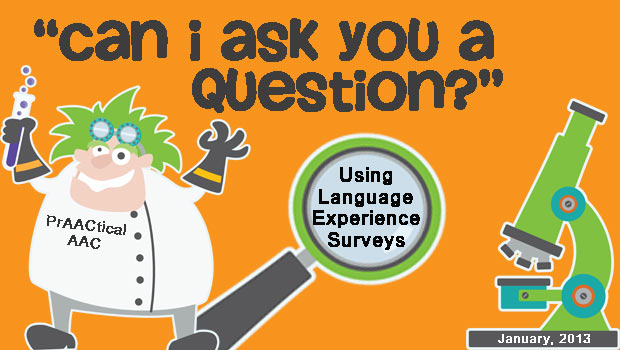
Want to give your AAC learners more frequent opportunities to interact with others? We love using Language Experience Surveys for this purpose. The concept is a simple one. Once you have a language goal in mind, craft a survey with a key question that the communicator can use as a conversation starter. After some instruction and practice, they can then ask people the question. You’ll need to create visual supports for the survey so that the communicator can use it as a cue and show to the interaction partners. In some surveys, the partners then use the visual support to record their responses. Putting the visual support on a clipboard works well in some situations. The simplest way to do this is with a forced-choice question with a list of response options. The survey could be about favorite TV shows or places to visit, for example, and show different options.... [Read More...]
January 17, 2013
by Carole Zangari -
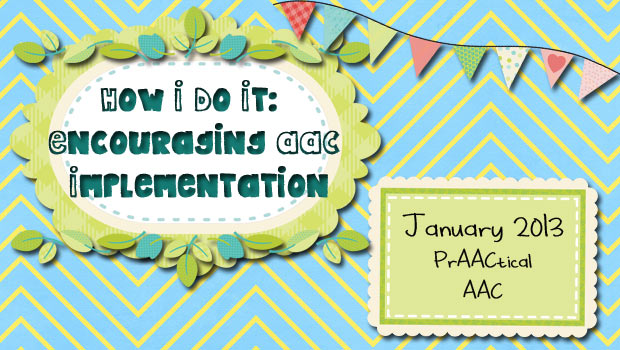
Nothing makes us happier than hearing AAC success stories. It’s thrilling to hear of folks who are using AAC tools and strategies to communicate effectively. We love hearing how their language develops and the positive changes that makes in their lives. It also makes us curious as to what made ‘this’ story a success story. One of our goals for the new year was to give PrAACtical AAC followers a look into the experiences of professionals outside their own communities. Last week, we introduced AACtual Therapy, a series of guest posts by SLPs who are willing to give us a peek into their AAC therapy sessions. Today, we introduce How I Do It, a series in which we invite SLPs to share how they tackle common issues, tasks, or problems. We’re excited to launch the series with a post from Lauren Enders, a clinician who supports the AAC community beyond... [Read More...]









